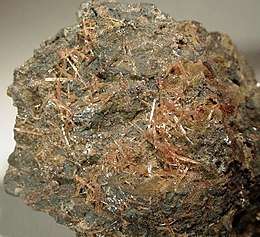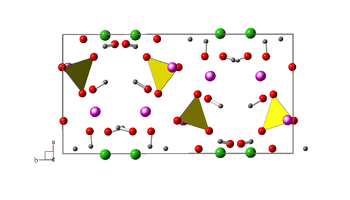Seamanite
| Seamanite | |
|---|---|
|
Seamanite crystals on a rock sample (5 x 4 x 3 cm) | |
| General | |
| Category | Borate minerals |
| Formula (repeating unit) | Mn3[B(OH)4](PO4)(OH)2[1] |
| Strunz classification | 6.AC.65[2] |
| Dana classification | 43.4.5.1[1] |
| Crystal system | Orthorhombic |
| Crystal class |
Dipyramidal (mmm) H-M symbol: (2/m 2/m 2/m)[3] |
| Space group | Pbnm |
| Unit cell |
a = 7.811 Å, b = 15.114 Å c = 6.691 Å, Z = 4 |
| Identification | |
| Formula mass | 372.64 g/mol[2] |
| Color | yellow, yellow-brown, pink[1] |
| Crystal habit | acicular[2] |
| Cleavage | distinct on {001}[3] |
| Fracture | brittle[2] |
| Tenacity | brittle[3] |
| Mohs scale hardness | 4[1] |
| Luster | vitreous[2] |
| Streak | white[2] |
| Diaphaneity | transparent[3] |
| Density | 3.08–3.128 g/cm3[3] |
| Refractive index |
nα = 1.640, nβ = 1.663, nγ = 1.665[4] |
| Birefringence | δ = 0.025[1] |
| 2V angle | ≈40°[4] |
| Dispersion | weak[1] |
| Ultraviolet fluorescence | none[2] |
| Solubility | in cold, dilute acids[1] |
| References | [3] |
Seamanite, named for discoverer Arthur E. Seaman, is a rare manganese boron phosphate mineral with formula Mn3[B(OH)4](PO4)(OH)2. The yellow to pink mineral occurs as small, needle-shaped crystals. It was first discovered in 1917 from a mine in Iron County, Michigan, United States and identified in 1930. As of 2012, seamanite is known from four sites in Michigan and South Australia.
History
In 1917, Arthur E. Seaman collected a mineral sample from the Chicagon Mine in Iron County, Michigan.[lower-alpha 1] He correctly believed it to be a new mineral species based on a qualitative analysis of its composition by F. B. Wilson. World War I delayed further study of the mineral until 1929. A study in 1930 proved it to be a new mineral and named it seamanite in honor of Seaman. They cited his career as a professor of geology and mineralogy and his contributions to the field as reasons for the naming.[5]
The original analysis of the mineral in 1930 suggested seamanite to be a hydrated salt.[6] However, in 1971, the mineral was determined to be the coordination compound Mn3[B(OH)4](PO4)(OH)2.[7]
Description
Seamanite is a transparent, yellow to pink mineral that occurs as needle-shaped crystals.[2] Seamanite is a brittle mineral with a mohs hardness of 4.[1] It is found in the crevices of fractured siliceous rock.[5] The type occurrence was found in association with small crystals of calcite, thin coatings of manganese oxide,[5] and fibrous sussexite.[8] Seamanite has also been found with shigaite.[9]
Distribution
As of 2012, seamanite is known from four locations: the Cambria-Jackson Mine in Marquette County, Michigan, the Chicagon Mine and the Bengal Mine in Iron County, Michigan, and the Iron Monarch open cut in the Eyre Peninsula, South Australia.[1]
The type material is stored at Michigan Technological University in Houghton, Michigan, and at the National Museum of Natural History in Washington, D.C. as sample 96282.[3]
Crystallography
Seamanite is formed of acicular crystals elongated along [001] and showing the faces {110} and {111} up to one centimeter. It has an orthorhombic crystal system and the Pbnm space group. The parameters of its unit cell are: a=7.811 Å, b=15.114 Å, c=6.691 Å, Z=4 units per unit cell.[3]
Notes
References
- 1 2 3 4 5 6 7 8 9 "Seamanite". Mindat. Retrieved April 13, 2012.
- 1 2 3 4 5 6 7 8 9 "Seamanite Mineral Data". Webmineral. Retrieved April 13, 2012.
- 1 2 3 4 5 6 7 8 "Seamanite" (PDF). Handbook of Mineralogy. Mineral Data Publishing. Retrieved April 13, 2012.
- 1 2 Kraus, p. 222
- 1 2 3 Kraus, p. 220.
- ↑ Kraus, p. 223–5
- ↑ Moore, p. 1527.
- ↑ Slawson, p. 575
- ↑ "Seamanite - Photo Gallery". Mindat. Retrieved April 13, 2012.
Bibliography
- Kraus, E.H.; Seaman, W.A.; Slawson, C.B. (June 1930). "Seamanite, a new manganese phospho-borate from Iron County, Michigan" (PDF). American Mineralogist. Mineralogical Society of America. 15 (6): 220–225. Retrieved April 13, 2012.
- Moore, Paul B.; Ghose, Subrata (September–October 1971). "A Novel Face-Sharing Octahedral Trimer in the Crystal Structure of Seamanite" (PDF). American Mineralogist. Mineralogical Society of America. 56 (9 & 10): 1527–1538. Retrieved April 13, 2012.
- Slawson, Chester B. (December 1934). "Sussexite from Iron County, Michigan" (PDF). American Mineralogist. Mineralogical Society of America. 19 (12): 575–578. Retrieved April 13, 2012.
Further reading
- Huminicki, Danielle M.C.; Hawthorne, Frank C. (2002). "Hydrogen Bonding in the Crystal Structure of Seamanite" (PDF). The Canadian Mineralogist. 40: 923–928. doi:10.2113/gscanmin.40.3.923. Retrieved April 14, 2012.
- McConnell, Duncan; Pondrom, Walter L., Jr. (July 1941). "X-ray Crystallography of Seamanite" (PDF). American Mineralogist. Mineralogical Society of America. 26 (7): 446–447. Retrieved April 13, 2012.
External links
![]() Media related to Seamanite at Wikimedia Commons
Media related to Seamanite at Wikimedia Commons

